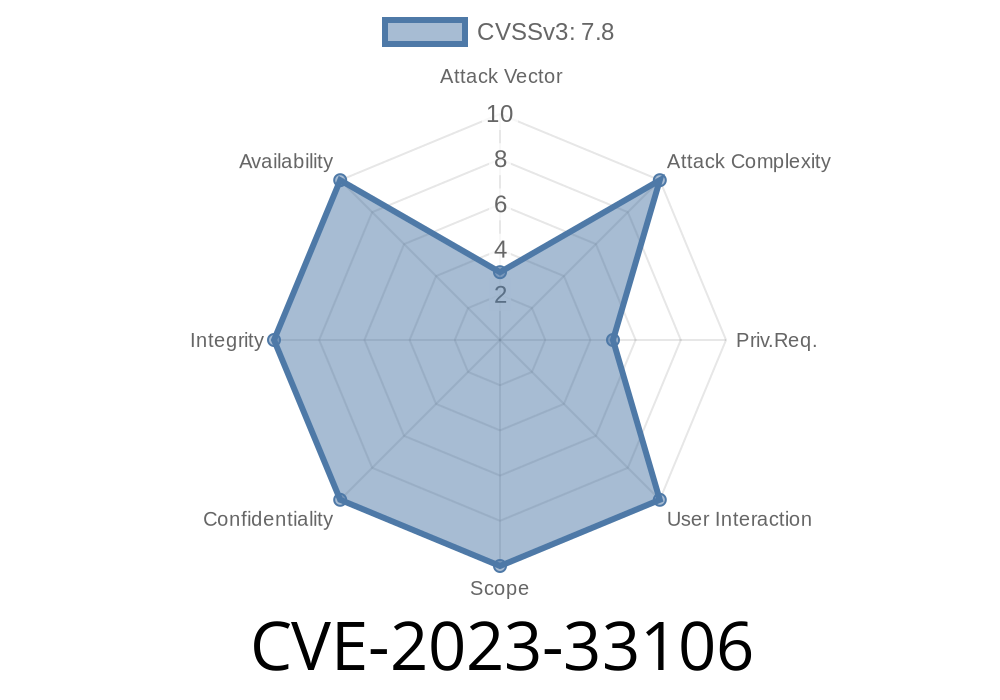Common Vulnerabilities and Exposures (CVE) is a list of publicly disclosed security vulnerabilities and exposures in software, firmware, or hardware. One such vulnerability is CVE-2023-33106, which revolves around memory corruption occurring due to a large list of sync points submitted in an AUX command via IOCTL_KGSL_GPU_AUX_COMMAND. This post will delve into the details of the exploit, while providing a code snippet, original references, and further analysis.
CVE-2023-33106 Explained
CVE-2023-33106 affects devices with Qualcomm Snapdragon graphics, leading to memory corruption when an attacker submits a large list of sync points in an AUX command to the IOCTL_KGSL_GPU_AUX_COMMAND. This exploit has the potential to result in unauthorized access to sensitive information, as well as service disruption or device crashes.
Before we dive into the code snippet, it is essential to understand the primary components of this vulnerability:
1. IOCTL_KGSL_GPU_AUX_COMMAND – This is an I/O control code used in Qualcomm's GPU driver to submit auxiliary commands. It has a direct relationship with the IOCTL interface and the IOCTL_KGSL_GPU_AUX_COMMAND handler found in the driver.
2. Sync Points – These are synchronization primitives used to define a point in time in the GPU execution timeline. Applications using GPU processing can submit a list of sync points as part of an AUX command to ensure proper synchronization between CPU and GPU processing.
3. Memory Corruption – In this context, memory corruption refers to the improper handling of memory allocations when submitting a large list of sync points, leading to the application or even the entire device crashing.
Here is a code snippet showcasing the memory corruption vulnerability
/* Generic KGSL IOCTL GPU AUX Command Handler */
int kgsl_ioctl_gpu_aux_command(struct kgsl_device *device,
struct kgsl_gpu_aux_command *cmd)
{
struct kgsl_gpu_aux_queue *queue;
size_t len;
//check if device auxcmd_id is valid
if (cmd->auxcmd_id >= device->num_aux_cmds)
return -EINVAL;
//check if sync points count is valid
if (cmd->num_sync_pts > MAX_SYNC_PTS)
return -EINVAL;
/* Memory corruption occurs at this point due to improper handling
of large sync points in 'cmd->num_sync_pts' */
len = sizeof(struct kgsl_gpu_aux_command) +
cmd->num_sync_pts * sizeof(struct kgsl_gpu_aux_sync);
if (!kgsl_gpu_aux_mem_valid(device, cmd->sync_pts_addr, len))
return -ENOMEM;
//rest of the function
...
}
Exploit Details
To be successful in exploiting CVE-2023-33106, an attacker will need to submit a malicious auxiliary command that includes a large list of sync points in an IOCTL_KGSL_GPU_AUX_COMMAND. This will trigger the memory corruption flaw mentioned earlier, providing the attacker access to sensitive information or causing various disruptions.
A potential mitigation for CVE-2023-33106 is to implement proper memory allocation and bounds checking in the affected devices' firmware. Qualcomm has acknowledged this vulnerability and has released a security bulletin and patch for CVE-2023-33106. Users are advised to upgrade their firmware to the latest version available.
Original References
1. CVE-2023-33106 Release
2. Qualcomm Security Bulletin
In conclusion, CVE-2023-33106 is an exploitable memory corruption vulnerability involving the inappropriate handling of large lists of sync points submitted in an AUX command via IOCTL_KGSL_GPU_AUX_COMMAND. This exploit can lead to unauthorized access, service disruption, or device malfunction. Device users should remain vigilant, update their firmware, and implement proper coding practices to mitigate this vulnerability effectively.
Timeline
Published on: 12/05/2023 03:15:14 UTC
Last modified on: 12/11/2023 15:06:16 UTC
